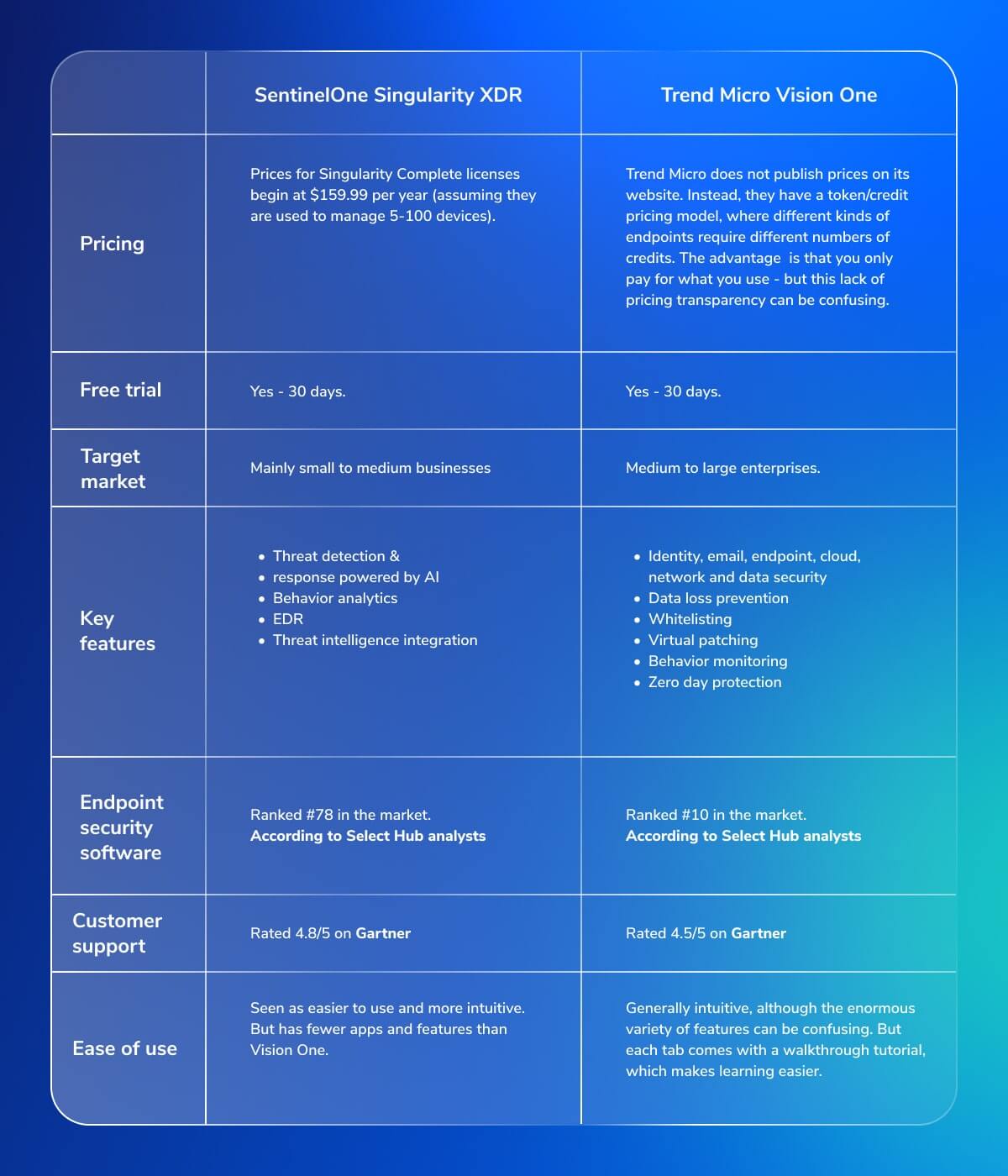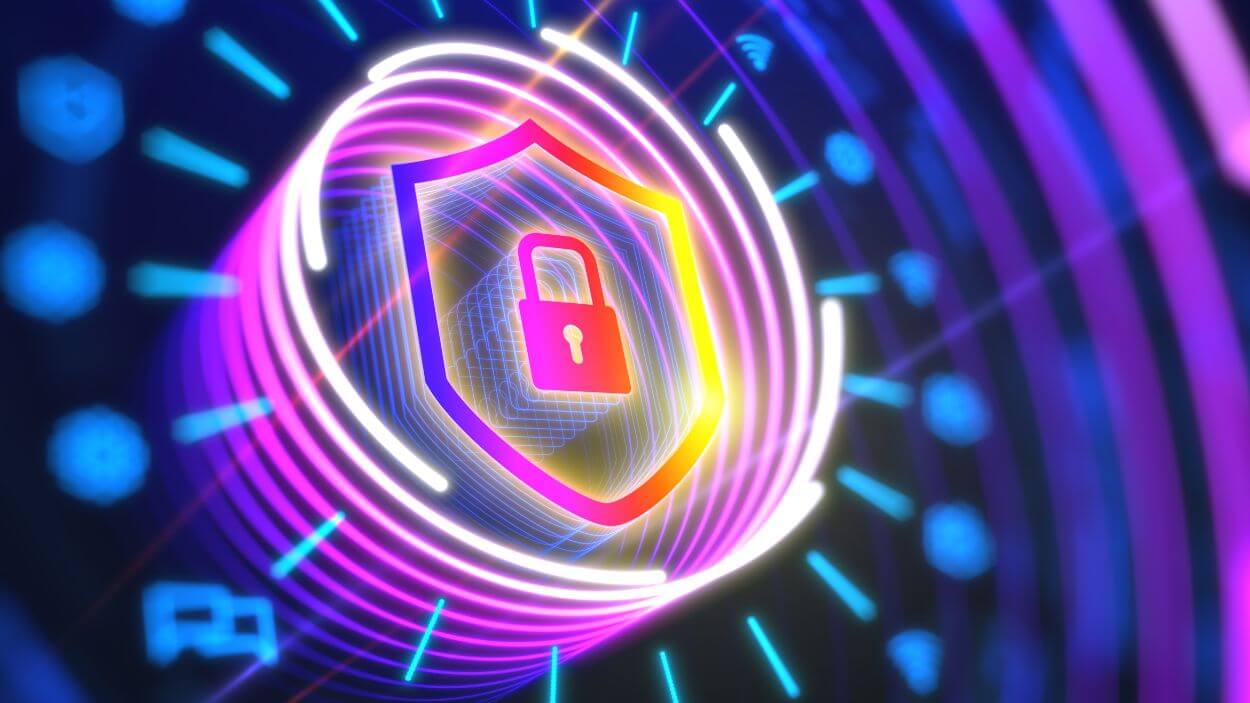Contents:
Cybersecurity-focused Managed Service Providers (MSPs) are dealing with more potential weak links than ever before. The cause? Endpoints.
MSPs’ clients are using far more endpoints than in the past. From mobile devices to web-connected printers, cloud storage to cloud apps, IoT sensors to BYOD.
One solution here is extended detection and response (XDR). Numerous cybersecurity firms have launched XDR platforms in recent years, and the market is growing rapidly. According to research by Global Market Insights, the industry is set to grow at an annual rate of 19%.
In this article, we compare Singularity XDR by SentinelOne vs. Trend Micro’s Vision One. What does each XDR do, how do they differ, and which is right for you?
Introducing SentinelOne’s Singularity XDR
Launched in February 2020, Singularity XDR is US business SentinelOne’s extended detection and response solution. SentinelOne say that Singularity XDR provides AI-powered prevention, detection, response, and threat hunting capacities across endpoints, containers, cloud workloads, and even IoT devices.
You get a cloud-based platform that collects telemetry from multiple tools and systems your customers use.
It consolidates this into what SentinelOne calls a ‘narrative’ (it basically details incident timelines), and can even automatically remediate issues. This is all supported by SentinelOne’s “AI”, which learns about threats and how to respond.
Introducing Trend Micro’s Vision One
Japanese firm Trend Micro has a long established reputation in cybersecurity. They launched Vision One, their XDR solution in 2021, and they describe it as ‘cloud-native platform, serving cloud, hybrid, and on-premises environments. The software combines ASM and XDR in a single console.
Again, it’s a cloud-based system that lets you monitor activity on all the endpoints you oversee remotely, and use machine learning to identify threats.
Like Singularity XDR, Vision One jumps into action automatically to control threats it identifies, then sends you a notification with more information.
SentinelOne vs. Trend Micro – Comparing Each Company’s XDR
Both SentinelOne and Trend Micro’s XDR solutions share several features and capabilities in common. That said, there are key differences too. Let’s compare SentinelOne vs. Trend Micro head to head.

SentinelOne vs. Trend Micro XDR: What the Experts Think
Systems administrators and MSP teams are, ultimately, the experts on these two platforms since they use them every day. So, what do they really think of these platforms?
Advantages And Disadvantages of Singularity XDR According to Users
Writing on Reddit, users describe the benefits of using Sentinel One’s XDR:
At the MSP I worked for, we had SentinelOne stop a ransomware attack. A user had downloaded a malicious .exe that was blocked from executing and after analysis, confirmed ransomware. We had every Sonicwall security product enabled along with Webroot running on that machine and S1 was the only product that identified and blocked it.
Reddit User on Singularity XDR
Other user said:
It is an extremely powerful tool that can give an incredible amount of detail and insight into problems.
Reddit User on Singularity XDR
But users also highlighted disadvantages of Singularity XDR too:
My experience has been poor. It really slows machines down and the false positive rate was really high. I don’t understand the love for it.
Reddit User on Singularity XDR
Other user has shared the following about his company’s experience with the software:
We dumped SentinelOne and never looked back. The number of issues caused by S1’s bloated agent are more numerous than you will count. Didn’t even realize what a massive difference dumping it would make on end user performance until we did.
Reddit User Review on Singularity XDR
Advantages And Disadvantages of Vision One According to Users
Writing on G2, users describe benefits of life with Vision One:
The best thing about the suite is that it allows the integration of many of the security tools that the organization uses.
User on Vision One
Others who used the product said:
The things I like the most are features like running a remote script which makes it easy to patch and implement. Apart from that, its integration with firewall and other data sources for various tasks is very easy to implement and used.
User Review on Vision One
But users also highlighted drawbacks:
Vison One’s credit usage system is a bit confusing.
Too many features are added frequently and it isn’t easy to navigate.
SentinelOne vs. Trend Micro: Pros And Cons of Each Company’s XDR
Comparing SentinelOne with Trend Micro? It’s valuable to weigh up the pros and cons of each platform.
Pros And Cons of SentinelOne’s Singularity XDR
Advantages of Singularity XDR include:
- Ease of use
Singularity XDR is widely viewed as an easy to use platform, with a clean interface and intuitive layout. It therefore has a fairly short learning curve.
- Powerful
Singularity XDR provides a huge amount of detail and insight into problems. Its ability to provide a “narrative” timeline of incidents helps MSPs with making sense of them better.
- AI
SentinelOne’s XDR solution uses a proprietary machine learning technique that identifies unusual behavior and responds – which saves busy MSPs a lot of time.
Drawbacks of Singularity XDR include:
- Can slow machines
Depending on how Singularity XDR is configured, it can significantly slow down machines – causing a lot of frustration.
- Ineffective reporting
Some users find the reporting with Singularity XDR is inefficient, and compiling reports can be challenging.
Pros And Cons of Trend Micro’s Vision One
Advantages of Vision One include:
- Large arsenal of apps
Vision One has an enormous arsenal of apps to prevent security threats – thereby giving MSPs more power, while needing fewer third-party solutions.
- Holistic approach
Vision One provides a comprehensive approach to cybersecurity, giving MSPs access to tools that let them monitor all apps, users and endpoints.
- AI assistant
Vision One provides MSP users with an interactive AI security assistant that helps speed up tasks.
Drawbacks of Vision One include:
- Unclear pricing
Trend Micro do not publish their pricing online, and use an unusual credit/token system, which makes it hard to budget.
- Overwhelming number of features
As a long-established company, Trend Micro has packed Vision One with an enormous variety of tools. This can be confusing and hard to learn, however.
- Roll out
Implementing Vision One can sometimes take a few months, and there have been mixed reviews about the onboarding process.
SentinelOne vs. Trend Micro: Which Company’s XDR Is Right for You?
Both SentinelOne and Trend Micro provide robust XDR solutions. So, how can you choose between them?
Your Budget
Vision One will normally be the more expensive option than Singularity XDR.
Features
Vision One has a larger number of apps and security controls than Singularity XDR, so if you manage especially complex environments, it may be the better option.
Size of Your MSP
Singularity XDR is tailored more towards small and medium businesses, whereas Vision One is aimed more at large companies and enterprises.
Starting an MSP business? Read our guide to MSP marketing
Heimdal®: An Alternative Option in the SentinelOne Vs. Trend Micro Debate
Heimdal® is a market leading cybersecurity platform for MSPs. Our XDR solution is lightweight, fast and easy to use. It includes dozens of apps and features to help you with tasks like:
- Threat hunting;
- Automated remediation;
- Multi layered endpoint detection;
- Threat tracking scans;
- Advanced attack prevention;
- Vulnerability management;
- Patching;
- Privileged Access Management;
- Email security.
To learn more about Heimdal®, visit our product page.
Case study: How a UK MSP uses Heimdal for endpoint detection and response
SentinelOne vs. Trend Micro: Frequently Asked Questions
Our FAQs answer your key questions about the XDR solutions from SentinelOne and Trend Micro.
Which is better, Singularity XDR or Vision One?
Both Singularity XDR and Vision One are viewed as robust solutions. While they share many features in common, they are aimed at slightly different markets, so it is difficult to say one is better than the other. In fact, on product comparison site G2, both XDR solutions score 4.7/5, which suggests there’s little between them.
Is Singularity XDR cheaper than Vision One?
Yes, in most cases. The two platforms use very different fee structures, but since Singularity XDR charges a fixed annual fee per user, it will usually cost less than Vision One where you have to pay for tokens for each device monitored. Of course, if you only monitor a small number of devices, Vision One could work out as less expensive.
Which is easier to set up – Singularity XDR or Vision One?
While both solutions are relatively easy to install, Singularity XDR has a slightly better reputation for support and help with deployment and end user training than Vision One.


 Network Security
Network Security
 Vulnerability Management
Vulnerability Management
 Privileged Access Management
Privileged Access Management
 Endpoint Security
Endpoint Security
 Threat Hunting
Threat Hunting
 Unified Endpoint Management
Unified Endpoint Management
 Email & Collaboration Security
Email & Collaboration Security











